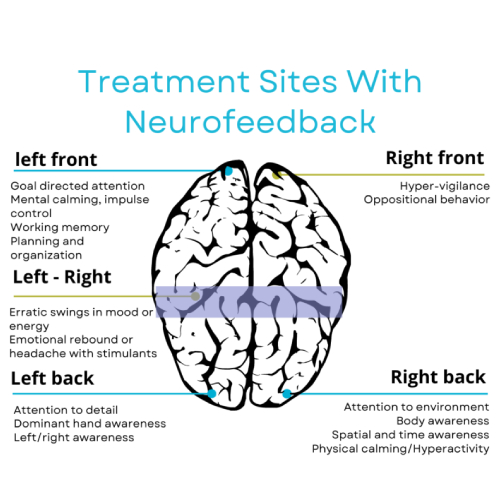ADHD, ADD, & LD's
A significant body of research has been conducted on Attention-Deficit Hyperactivity Disorder (ADHD), Attention-Deficit Disorder (ADD), and Learning Disorders (LD’s). With Neurofeedback we have found biomarkers in the brain for attention issues. A Brain Map (QEEG) allows us to see where the frequencies are misaligned. Patients are frequently able to go off of stimulant medications after neurofeedback sessions are employed. Sleep is also regulated, since dysregulated sleep has a significant impact on focus and attention.
Reducing symptoms of ADHD with Neurofeedback is centered around enhancing specific areas of the brain crucial for attention, executive function, and impulse control—primarily targeting the frontal lobes. Numerous studies in neuroscience have demonstrated that non-pharmaceutical interventions, such as exercise, brain training, specific supplements, and neurofeedback, can effectively enhance frontal lobe functions.

Dr. Kakaiya identifies factors that can naturally improve each patient’s attention and guides patients in making healthier daily choices. The concurrent use of neurofeedback treatment, alongside integrative suggestions, aids in fostering a sense of calmness and increasing focus.
ADHD is a extensively studied domain for Neurofeedback training. Neurofeedback consistently exhibits minimal or no notable side effects and significantly contributes to positive neuropsychological and behavioral outcomes related to ADHD. This involves a decrease in symptoms of inattention and hyperactivity. Other research underscores its ability to improve emotional self-regulation and self-control, effectively addressing issues with overactivity and functional deficits.
Studies
Arns M, Drinkenburg W, Leon Kenemans J. (2012). The effects of QEEG-informed neurofeedback in ADHD: an open-label pilot study. Appl Psychophysiol Biofeedback. 2012 Sep;37(3):171-80. In addressing ADHD, numerous EEG biomarkers have been identified, particularly in connection with the effectiveness of stimulant medication. This pilot study sought to tailor neurofeedback treatment to these specific EEG biomarkers related to ADHD, aiming to enhance clinical outcomes. The objective was to personalize neurofeedback protocols for distinct sub-groups and explore whether this targeted approach could yield improved results. Moreover, the study delved into the neurophysiological effects of neurofeedback by examining pre- and post-treatment EEG and ERP changes in a selected sub-group. Using QEEG-informed neurofeedback, twenty-one ADHD patients underwent treatment, and the impact on inattention (ATT), hyperactivity/impulsivity (HI), and concurrent depressive symptoms was assessed. The results were compelling, indicating a significant enhancement in both inattention, hyperactivity/impulsivity and comorbid depressive symptoms following QEEG-informed neurofeedback. This pilot study stands out as the first to demonstrate the feasibility of selecting neurofeedback protocols based on individual EEG biomarkers, suggesting a notable improvement in treatment outcomes, especially regarding inattention. Nevertheless, it is crucial to note that these findings should be substantiated through further controlled studies. The application of SMR neurofeedback showcased specific changes in ERP and EEG, underscoring the targeted efficacy of this approach.
